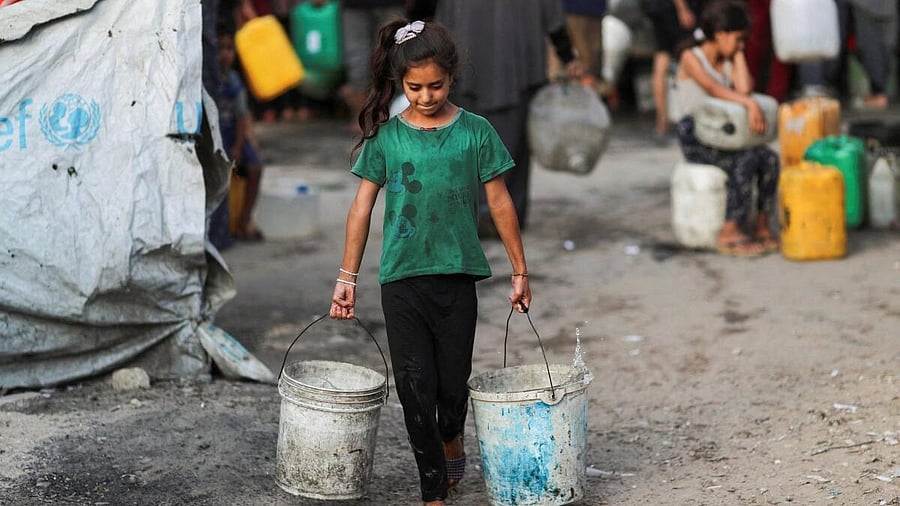
A Palestinian girl carries buckets of water amid shortages, in Gaza City August 6, 2025.
Credit: Reuters Photo
Gaza: Weakened by hunger, many Gazans trek across a ruined landscape each day to haul all their drinking and washing water - a painful load that is still far below the levels needed to keep people healthy.
Even as global attention has turned to starvation in Gaza, where after 22 months of a devastating Israeli military campaign a global hunger monitor says a famine scenario is unfolding, the water crisis is just as severe according to aid groups.
Though some water comes from small desalination units run by aid agencies, most is drawn from wells in a brackish aquifer that has been further polluted by sewage and chemicals seeping through the rubble, spreading diarrhoea and hepatitis.
COGAT, the Israeli military agency responsible for coordinating aid in the Israeli-occupied Palestinian territories, says it operates two water pipelines into the Gaza Strip providing millions of litres of water a day.
Palestinian water officials say these have not been working recently.
Israel stopped all water and electricity supply to Gaza early in the war but resumed some supply later though the pipeline network in the territory has been badly damaged.
Most water and sanitation infrastructure has been destroyed and pumps from the aquifer often rely on electricity from small generators - for which fuel is rarely available.
COGAT said the Israeli military has allowed coordination with aid organisations to bring in equipment to maintain water infrastructure throughout the conflict.
Moaz Mukhaimar, aged 23 and a university student before the war, said he has to walk about a kilometre, queuing for two hours, to fetch water. He often goes three times a day, dragging it back to the family tent over bumpy ground on a small metal handcart.
"How long will we have to stay like this?" he asked, pulling two larger canisters of very brackish water to use for cleaning and two smaller ones of cleaner water to drink.
His mother, Umm Moaz, 53, said the water he collects is needed for the extended family of 20 people living in their small group of tents in Deir al-Balah in the central Gaza Strip.
"The children keep coming and going and it is hot. They keep wanting to drink. Who knows if tomorrow we will be able to fill up again," she said.
Their struggle for water is replicated across the tiny, crowded territory where nearly everybody is living in temporary shelters or tents without sewage or hygiene facilities and not enough water to drink, cook and wash as disease spreads.
The United Nations says the minimum emergency level of water consumption per person is 15 litres a day for drinking, cooking, cleaning and washing. Average daily consumption in Israel is around 247 litres a day according to Israeli rights group B'Tselem.
Bushra Khalidi, humanitarian policy lead for aid agency Oxfam in the Israeli-occupied Palestinian territories said the average consumption in Gaza now was 3-5 litres a day.
Oxfam said last week that preventable and treatable water-borne diseases were "ripping through Gaza", with reported rates increasing by almost 150% over the past three months.
Israel blames Hamas for the suffering in Gaza and says it provides adequate aid for the territory's 2.3 million inhabitants.
Queues for water
"Water scarcity is definitely increasing very much each day and people are basically rationing between either they want to use water for drinking or they want to use a lot for hygiene," said Danish Malik, a global water and sanitation official for the Norwegian Refugee Council.
Merely queuing for water and carrying it now accounts for hours each day for many Gazans, often involving jostling with others for a place in the queue. Scuffles have sometimes broken out, Gazans say.
Collecting water is often the job of children as their parents seek out food or other necessities.
"The children have lost their childhood and become carriers of plastic containers, running behind water vehicles or going far into remote areas to fill them for their families," said Munther Salem, water resources head at the Gaza Water and Environment Quality Authority.
With water so hard to get, many people living near the beach wash in the sea.
A new water pipeline funded by the United Arab Emirates is planned, to serve 600,000 people in southern Gaza from a desalination plant in Egypt. But it could take several more weeks to be connected.
Much more is needed, aid agencies say. UNICEF spokesperson James Elder said the long-term deprivations were becoming deadly. "Starvation and dehydration are no longer side effects of this conflict. They are very much frontline effects."
Oxfam's Khalidi said a ceasefire and unfettered access for aid agencies was needed to resolve the crisis.
"Otherwise we will see people dying from the most preventable diseases in Gaza - which is already happening before our eyes."